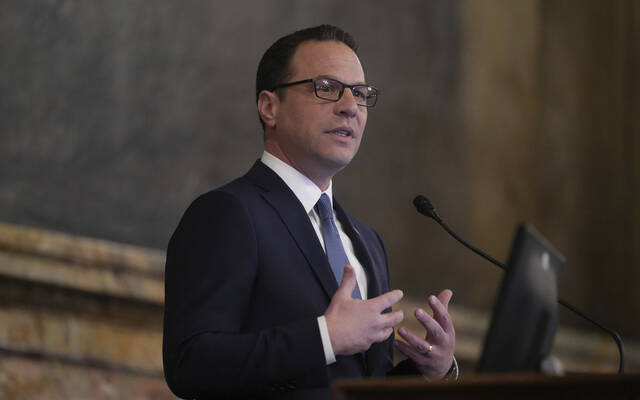They call it a moonshot for a reason. It’s exceedingly difficult.
Only about half of all lunar missions have been successful, according to NASA’s database on moon missions.
Pittsburgh-based company Astrobotic was attempting to beat the odds Monday by sending its Peregrine lander to the moon to transport cargo for NASA. The lander was to be controlled on the moon’s surface with robotics from mission control back in the U.S.
After an up-and-down start that provided minor setbacks and then glimmers of hope, Astrobotic announced a “critical” malfunction with the lander’s propulsion system, leading to a loss of fuel. The company hinted in a statement that reaching the moon appeared unlikely.
“Unfortunately it appears the failure within the propulsion system is causing a critical loss of propellant,” the company said Monday afternoon. “The team is working to try and stabilize this loss, but given the situation, we have prioritized maximizing the science and data we can capture.”
Astrobotic was able to get an image of Peregrine in space, which showed a disturbance of the craft’s insulation. The company said the damaged insulation is the first visual clue that points to the propulsion system experiencing an anomaly.
But all is not lost for Astrobotic.
Other parts of the lander are still functional, and mission control is using Peregrine’s existing power to “perform as many payload and spacecraft operations as possible,” Astrobotic said.
NASA is not sulking over Peregrine’s issues, emphasizing that there are valuable lessons to learn.
And Astrobotic will have another shot at landing on the moon if it goes forward with the launch of another lunar lander, possibly later this year.
Peregrine’s path
Peregrine blasted off aboard United Launch Alliance’s Vulcan rocket around 2:18 a.m. from Cape Canaveral, Fla. The lander is about 6 feet tall and 8 feet wide, with a payload capacity of about 265 pounds.
After a successful launch, Peregrine began to experience a variety of issues.
Astrobotic released a statement about six hours after the craft separated from Vulcan, indicating that an error was preventing the company from “achieving a stable sun-pointing orientation.” The lander uses solar panels to charge its batteries and operate its equipment.
Without power, Astrobotic said the spacecraft would face trouble landing softly on the moon. Peregrine also lost the ability to communicate with mission control.
The team was blacked out.
Three hours later, Astrobotic managed to reorient the lander’s solar panels to aid in recharging its battery. Peregrine also recovered its communication ability with mission control.
The lander started to recharge.
But when communication was reestablished, Astrobotic discovered the lander’s propulsion system was malfunctioning, causing a critical loss of fuel to move Peregrine on its long journey to the moon.
Peregrine was set to move methodically on a trajectory to the moon, taking about five days, Astrobotic CEO John Thornton told TribLive in October.
The lander was then supposed to move into the moon’s orbit, and wait for the best time to descend.
Thornton said Astrobotic needs to ensure the right lighting is available at the landing spot, noting the moon receives 14 days of sunlight at a time, followed by 14 days of darkness.
Peregrine was scheduled to touch down Feb. 23. Because Peregrine is run by robotics, it can take a longer and more fuel-efficient route to get to the moon, Thornton said.
But, with a critically low amount of fuel left, reaching the moon appears to be a long shot.
NASA response
The federal space agency acknowledged Peregrine’s challenges but noted that even a mission that fails to reach the moon can still provide valuable information.
“Each success and setback are opportunities to learn and grow,” said Joel Kearns, deputy associate administrator for exploration at NASA’s Science Mission Directorate in Washington. “We will use this lesson to propel our efforts to advance science, exploration, and commercial development of the Moon.”
NASA Administrator Bill Nelson didn’t dwell on the missteps and hailed the successful launch of the rocket and lander into space. Before Monday, the U.S. hadn’t launched a moon-landing mission since 1972.
He said “spaceflight is a daring adventure” and praised Astrobotic for making progress in lunar deliveries and for NASA’s Artemis program, which looks to return astronauts to the moon’s surface within the next few years.
Nelson said NASA will continue to grow with commercial partners like Astrobotic. NASA awarded $79.5 million to Astrobotic to deliver payloads to the moon.
Houston-based Intuitive Machines is also attempting to land on the moon this year, with a scheduled launch date for mid February.
Another attempt
Peregrine’s apparent failure to reach the moon won’t be Pittsburgh’s only shot to make history.
Thornton told TribLive last year Astrobotic is working on launching another lander to help a NASA lunar rover explore the moon, in order to drill near its pole looking for water and ice.
That mission is on track for a launch in late 2024.








